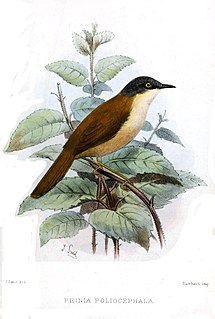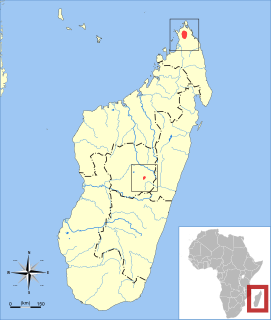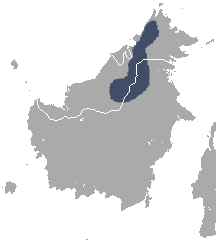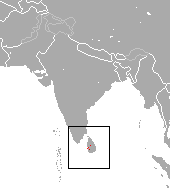
The northern naked-tailed armadillo is a species of armadillo. It is one of only two species of armadillo found outside of South America, the other being the more widely distributed nine-banded armadillo.
The Ethiopian forest brush-furred rat or golden-footed brush-furred rat, is a species of rodent in the family Muridae. It is endemic to Ethiopia where its natural habitat is subtropical or tropical moist montane forests. It is threatened by habitat loss.

Brants's whistling rat or Brants' whistling rat is one of two species of murid rodent in the genus Parotomys. It is found in Botswana, Namibia, and South Africa where its natural habitats are subtropical or tropical dry shrubland and pastureland. It was first described in 1834 by the Scottish zoologist Andrew Smith who named it in honour of the Dutch zoologist and author Anton Brants.
The Guinean gerbil is a species of rodent found in Burkina Faso, Gambia, Ghana, Guinea, Guinea-Bissau, Ivory Coast, Mali, Senegal, Sierra Leone, and possibly Liberia. Its natural habitats are subtropical or tropical dry forests, dry savanna, rocky areas and arable land, but it is mostly found in areas laterite or clay soils, and with variable amounts of vegetation and dense scrub. This species is described as common and has a stable population and a wide distribution, so the International Union for Conservation of Nature has rated its conservation status as being of "least concern".

The little woodstar, colibri bourdon, colibrí abejorro, or estrellita chica is a species of hummingbird in the family Trochilidae. It is found in Colombia, Ecuador and Peru.

The tailless tenrec, also known as the common tenrec, is a species of mammal in the family Tenrecidae. It is the only member of the genus Tenrec. Native to Madagascar, it is also found in the Comoros, Mauritius, Réunion, and Seychelles, where it has been introduced. Its natural habitats are subtropical or tropical dry forest, subtropical or tropical moist lowland forest, subtropical or tropical moist montane forest, dry savanna, moist savanna, subtropical or tropical dry shrubland, subtropical or tropical moist shrubland, subtropical or tropical high-altitude shrubland, subtropical or tropical dry lowland grassland, subtropical or tropical high-altitude grassland, arable land, pastureland, plantations, rural gardens, and urban areas.

Ichthyophis glutinosus, the Ceylon caecilian or common yellow-banded caecilian, is a species of caecilian in the family Ichthyophiidae endemic to Sri Lanka. Its natural habitats are moist tropical and subtropical forests and pastures.

Archer's lark, also known as Liben lark is a species of lark in the family Alaudidae. It is found in Somalia, Somaliland and Ethiopia. Its natural habitats are subtropical or tropical dry shrubland and subtropical or tropical dry lowland grassland. It is threatened by habitat loss. The bird's common name and binomial commemorate the British explorer and colonial official Sir Geoffrey Francis Archer.

The black-chested jay is a species of bird in the family Corvidae.

The Yucatan jay is a species of bird in the family Corvidae, the crows and their allies. It is native to the Yucatán Peninsula where its habitats are subtropical or tropical dry forest, plantations and cleared areas at altitudes up to 250 m (820 ft). Adults are about 30 cm (12 in) long, black, with blue wings, mantle, and tail, black bills, yellow eye rings and legs. Immature birds have yellow bills. This is a common species of jay with a wide range and the International Union for Conservation of Nature has rated its conservation status as being of "least concern".

The spot-breasted oriole is a species of bird in the family Icteridae.

The grey-crowned prinia is a species of bird in the family Cisticolidae. It is found in Bhutan, northern India and Nepal. Its natural habitats are subtropical or tropical dry forest, subtropical or tropical moist shrubland, subtropical or tropical dry lowland grassland, subtropical or tropical seasonally wet or flooded lowland grassland, and arable land. It is threatened by habitat loss.

The ivory-billed woodcreeper is a species of bird of the order of Passerformes, which are perching birds. It is in the family Furnariidae (ovenbirds) and the subfamily Dendrocolaptinae (woodcreepers).

The black dorcopsis or black forest wallaby is a species of marsupial in the family Macropodidae. It is endemic to an island at the eastern end of New Guinea where its natural habitat is subtropical or tropical dry forests. It is threatened by habitat loss and hunting, its population is declining and the IUCN lists it as being "Critically endangered".

The lesser long-tailed shrew tenrec is a species of mammal in the family Tenrecidae. It is active at all hours of the day and night, but each individual maintains its own pattern of rest and activity.

The greater fairy armadillo, also known as Burmeister's armadillo or the Chacoan fairy armadillo, is a species of armadillo in the family Chlamyphoridae. It is found in Argentina, Bolivia, and Paraguay. Its natural habitats are subtropical or tropical dry shrubland and subtropical or tropical dry lowland grassland. It is threatened by habitat loss and persecution. It is the only species in the genus Calyptophractus.

The Bornean smooth-tailed treeshrew is a species of treeshrew in the family Tupaiidae. It is endemic to Borneo. Its natural habitat is subtropical or tropical dry forests. It is threatened by habitat loss.

Pearson's long-clawed shrew is a species of mammal in the family Soricidae. It is monotypic within the genus Solisorex. It is endemic to Sri Lanka. Its natural habitats are subtropical or tropical dry forests and subtropical or tropical dry lowland grassland. It is threatened by habitat loss. It is known as ශ්රී ලංකා නියදිගු මා හික් මීයා in Sinhala.

The Asian highland shrew is a species of mammal in the family Soricidae. It is found in India and Sri Lanka. Its habitat is subtropical or tropical dry forests. It is threatened by habitat loss. It is known as ශ්රී ලංකා කදු හික් මීයා in Sinhala.

The jungle shrew is a species of mammal in the family Soricidae endemic to Sri Lanka. Its natural habitat is subtropical or tropical dry forests. It is threatened by habitat loss.



















